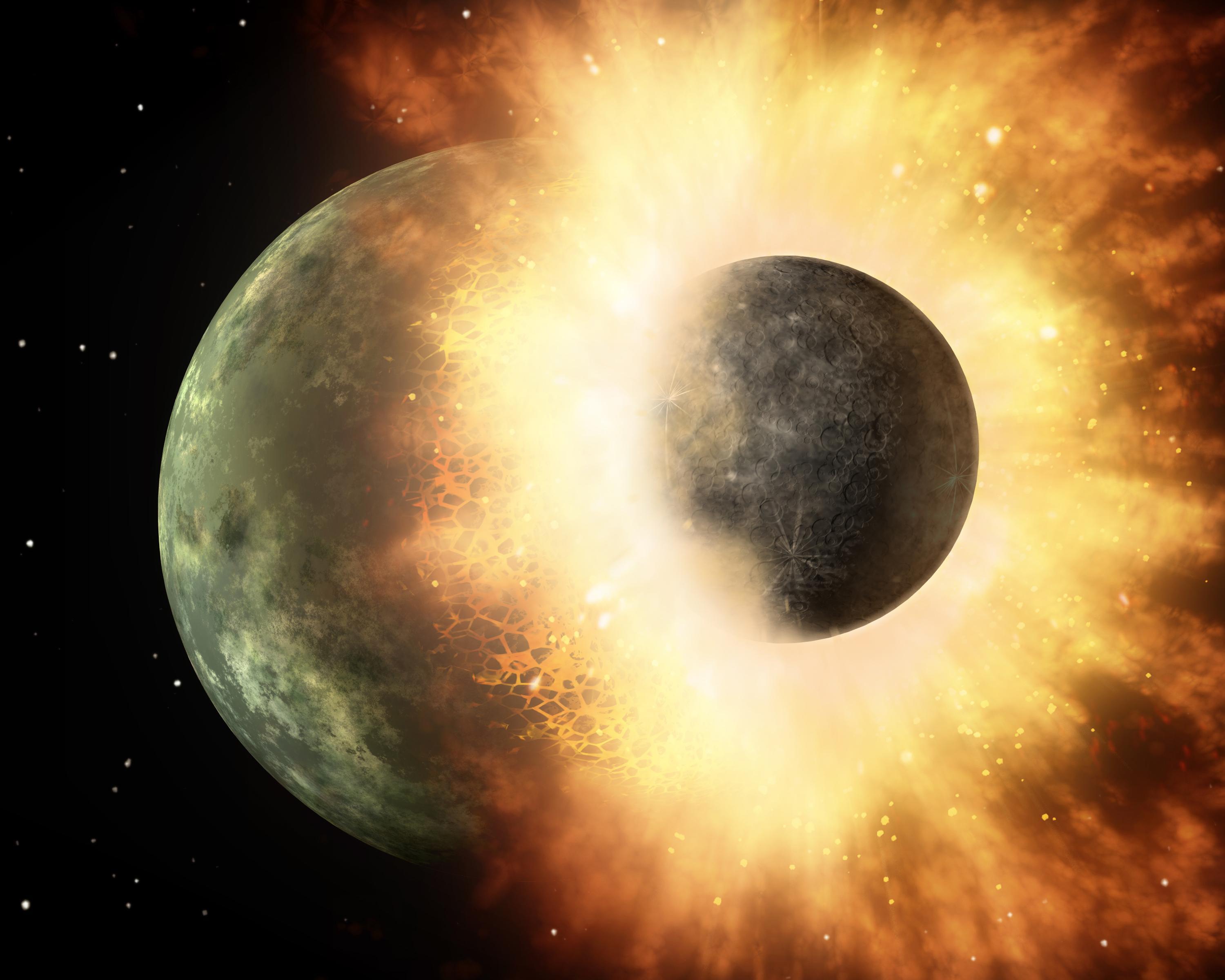How was Earth’s moon formed? Matija Ćuk has been working with researchers Simon Lock and Sarah Stewart on a new theory.

How was Earth’s moon formed? I have been working with lead-researchers Simon Lock and Sarah Stewart (now at U.C. Davis) on a new theory.
It is generally accepted by most planetary scientists that the Moon was formed in a giant collision between a growing Earth and another, smaller, proto-planet at the end of Earth's formation, about 4.5 billion years ago. However, there is little agreement about the details of this collision and how exactly it led to the formation of the Moon.
This is in stark contrast to the situation fifteen years ag. Back then we thought we had the parameters of the collision well-constrained based upon Earth's spin and the Moon's size. In this "classical giant impact" story a Mars-sized body hit Earth, at a relatively slow speed, along the plane of its orbit and somewhat off-center, and that this collision produced a disk of debris orbiting Earth, from which the Moon formed.
One relatively little-known aspect of the classical giant impact theory was that the material that forms the Moon originated mostly from the impactor. However, new analyses of lunar samples have shown that the Moon is extremely similar to Earth in terms of its "isotopic signature. " What this means is that Earth as well as various bodies we have meteorites from (Mars, Vesta, plus some long-gone nameless bodies pieces of which are still around) all contain an abundance of isotopes of the same chemical element (e.g. ratio between number of oxygen-18 to oxygen-16 atoms). Cosmochemists can tell if a new meteorite is from any of the known bodies using this isotopic signature. So, we would expect that the proto-lunar impactor was isotopically distinguishable from Earth, but the opposite was found: the Moon is made of the same raw material as Earth.
In 2012, Sarah Stewart and I proposed that the solution to the question of lunar formation is tied to the loss of angular momentum at impact. All prior theories assumed that spin period of Earth at the time of lunar formation was 5 hrs., a straightforward result first obtained by G. H. Darwin (son of Charles) in 19th century. This figure is based on the assumption that Earth and the Moon, taken together, still preserve the initial angular momentum of the pair after the giant impact. In our 2012 paper, I showed that an orbital resonance between the Sun and the Moon in the distant past can remove spin from Earth-Moon system and transfer it to Earth's orbit around the Sun. In the same paper, Sarah showed that if we assume Earth was spinning twice faster than we previously thought, impact can eject mostly Earth material into orbit, and an isotopically Earth-like Moon can form.
Since then, there has been much more work done on lunar formation, and I am glad to say that the high angular momentum idea appears to be here to stay. However, it was pointed out that both of our proposed effects, spin loss through a resonance and ejection of Earth mantle rocks in an impact, require somewhat fine-tuned properties of the impact, as well as Earth and the Moon after formation. After much further work, I realized that Earth can lose spin much more readily and robustly if its initial spin axis tilt was large, 70 degrees or more. This high tilt is actually quite likely for planets formed through giant impacts with random directions. Complex orbital interaction between Earth, Moon and the Sun can slow down Earth's spin, straighten up its spin axis, and produce the Moon with the correct current orbit.
On the formation front, Sarah Stewart and her student Simon Lock have realized that the formation of a disk around a hot, fast-spinning Earth is not the relatively neat affair we thought it to be. Fast-spinning Earth "pancakes out" at the equator, while the extreme energies of the impact have vaporized large chunks of Earth, making it impossible to say where the boundaries are between the mantle, atmosphere and the circum-terrestrial disk. They named this structure "synestia", for it is a common hearth containing the fires of Earth and the Moon in the process of formation. Since Earth is seamlessly coupled with the disk that the Moon will form from, material is exchanged between the two for the duration of the synestia phase, naturally explaining the similar compositions of Earth and the Moon.
While the ideas of a highly-titled Earth embedded in a hot, donut-shaped synestia may appear exotic, this is where the study of lunar formation has led us. These theories have the benefit that they simply need a random and violent impact onto Earth, and no fine-tuning of the impact's parameters is needed to explain the outcome. We will see how these ideas fare with time, and whether further surprises await us. One thing is certain: while the giant impact theory is not going anywhere, we cannot fix its classical version with small tweaks, and we must really think outside the box when it comes to lunar formation. Unless we are taking about a box of donuts, which does contain a rough model of a synestia.
Further reading (open access):
Ćuk et al. (2016) on early high-obliquity Earth. https://arxiv.org/abs/1802.03356
Lock and Stewart (2017) on the concept of synestia. https://arxiv.org/abs/1705.07858
Lock et al. (2018) on lunar formation from a synestia. https://arxiv.org/abs/1802.10223





